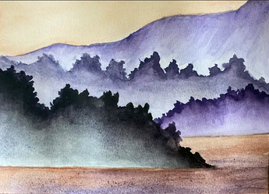M. Schlein J-11
Foggy Landscape Watercolor Painting Inspired by Traditional Chinese Landscapes

Image: XuLing. Landscape. Date Unknown.
Article: Moffat, Charles. “Mountain Water.” The Art History Archive, 2008.
Both the image and the article are from: www.arthistoryarchive.com/arthistory/asian/Chinese-Landscape-Painting.html.
Overview of the plan:
This project is designed to introduce students to traditional Chinese landscape paintings. This lesson with culminate in the creation of their own misty mountain watercolor painting.
-
Students will read an excerpt from the article Mountain Water by Charles Moffat.
-
Students will watch the video Ancient Art Links - Chinese Landscape Paintings at the Metropolitan Museum.
-
Students will paint three pine trees with watercolor.
-
Students will create a painting of misty mountains by using watercolor.
Mountain Water by Charles Moffat
Many critics consider landscape to be the highest form of Chinese painting. The time from the Five Dynasties period to the Northern Song period (907-1127) is known as the "Great age of Chinese landscape". In the north, artists such as Jing Hao, Fan Kuan, and Guo Xi painted pictures of towering mountains, using strong black lines, ink wash, and sharp, dotted brushstrokes to suggest rough stone. In the south, Dong Yuan, Ju Ran, and other artists painted the rolling hills and rivers of their native countryside in peaceful scenes done with softer, rubbed brushwork. These two kinds of scenes and techniques became the classical styles of Chinese landscape painting.
Beginning in the Tang Dynasty, many paintings were landscapes, often shanshui ("mountain water") paintings. In these landscapes, monochromatic and sparse (a style that is collectively called shuimohua), the purpose was not to reproduce exactly the appearance of nature (realism) but rather to grasp an emotion or atmosphere so as to catch the "rhythm" of nature.
By the late Tang dynasty, landscape painting had evolved into an independent genre that embodied the universal longing of cultivated men to escape their quotidian world to commune with nature. Such images might also convey specific social, philosophical, or political convictions. As the Tang dynasty disintegrated, the concept of withdrawal into the natural world became a major thematic focus of poets and painters. Faced with the failure of the human order, learned men sought permanence within the natural world, retreating into the mountains to find a sanctuary from the chaos of dynastic collapse.
In the Song Dynasty period (960-1279), landscapes of more subtle expression appeared; immeasurable distances were conveyed through the use of blurred outlines, mountain contours disappearing into the mist, and impressionistic treatment of natural phenomena. Emphasis was placed on the spiritual qualities of the painting and on the ability of the artist to reveal the inner harmony of man and nature, as perceived according to Taoist and Buddhist concepts. One of the most famous artists of the period was Zhang Zeduan, painter of Along the River During the Qingming Festival.
Examples of Chinese Landscape Paintings at The Metropolitan Museum of Art (New York, NY)
Now that you've learned some history about the tradition of foggy landscapes you will begin to paint your own.
Begin by completing the activity in the video below. 3 ways to paint a Pine Tree with Watercolor.

Examples made by MHS students
After you are done painting your trees it is time to paint your graded project: Fog with Watercolor.
When you are done painting your landscape:
-
Take a photo of your artwork.
-
Upload the image onto Google Classroom.
Examples made by MHS students







